Whilst pricing is a pivotal factor in marketing a product, it’s not always just a question of how much. You can show you’ve gone above an beyond by offering a personalized custom price quote calculator.
This article delves into the world of price quote calculators, and how they can transform your business.
What is a price quote calculator?
Price quote calculators are designed to estimate the cost of products or services, providing potential customers with customized price quotes or estimates.
They serve as a bridge between businesses and customers, offering transparency and trust.
Customers are empowered with the ability to receive instant, personalized quotes, while businesses benefit from streamlined operations and enhanced customer satisfaction.
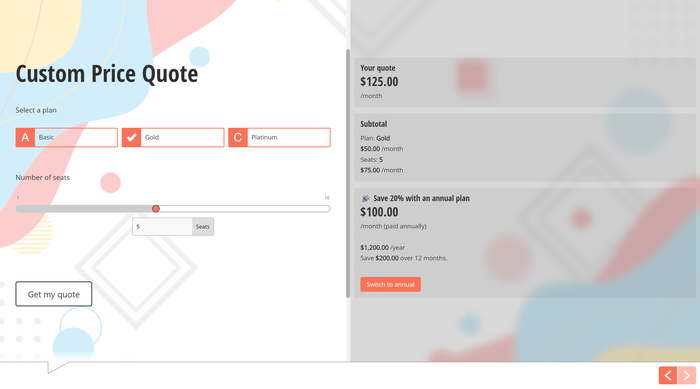
Before you get started, you’ll need to choose one of the best online calculator builders that suit your needs.
How to build a price quote calculator
Let’s get stuck into building a price quote calculator.
We’ll break this down into 5 easy steps, and delve into the different ways to personalize experiences for potential customers.
Step 1: Select the calculator project type
You’ll be able to create a variety of projects with Shout, including custom calculators, surveys, quizzes and forms.
Click the + icon and select the Calculator project type to get started. From here you can name your calculator, for this example we’ll go with “custom price quote calculator”.
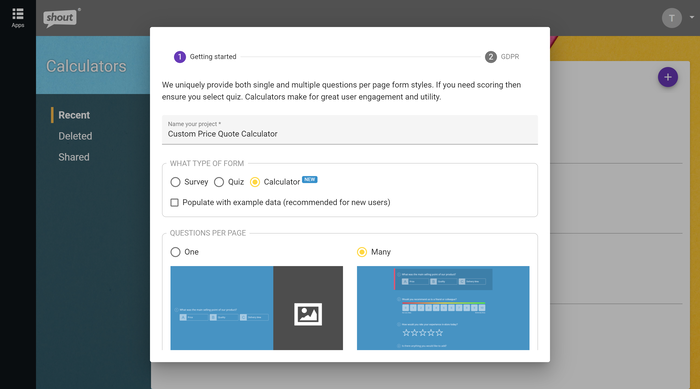
You also have the choice between two navigation styles for calculators; single question per page or multi-question pages.
Single question per page calculators
Single question per page calculators do what they say on the tin. Each field will be displayed individually, and once potential customers input an answer they’ll be moved to the next page seamlessly.
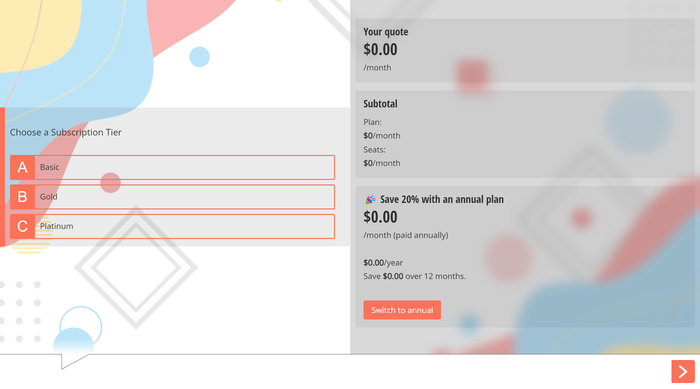
Multi-question per page calculators
This navigation style allows you to add multiple questions or field on the same page. You can still add more pages to break up your calculators into multiple-steps.
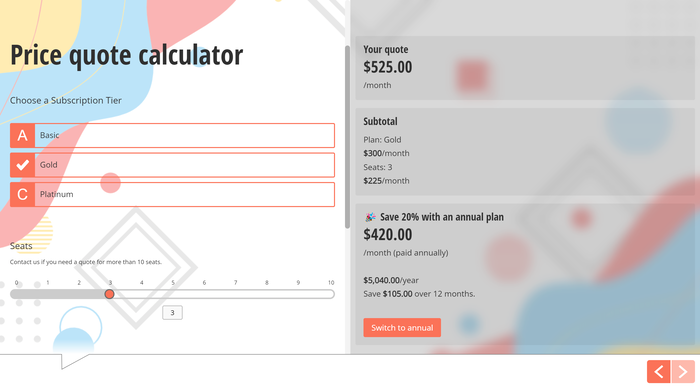
Step 2. Add questions and fields
Once you’ve created a calculator project type, you’ll be taken to the builder. From here you can add questions, customize designs, and manage all calculator settings.
Click ‘New question’ in the left sidebar to open the question types library. You’ll have a huge selection of questions and fields for your calculators, including:
- Sliders (Opinion Slider, Numeric Slider)
- Numeric fields (Currency, Age, Integer, Decimal)
- Multiple-choice (Single-Select, Multi-Select)
- Picture-choice (Single-Select, Multi-Select)
- Contact fields (Contact Form, Email Field, Website Field, Phone Number Field)
- And much more!
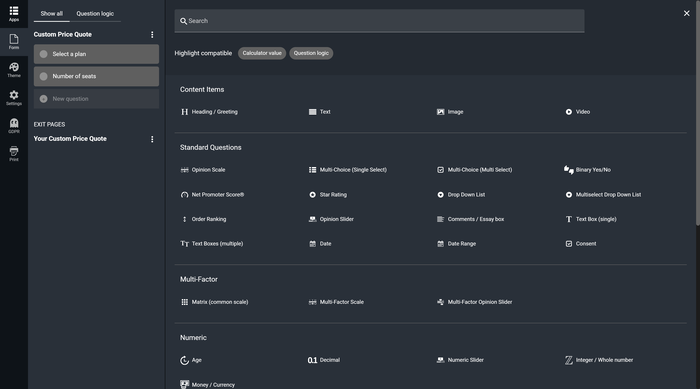
Step 3. Assign values and build a formula
The next step is to assign values to answer options, these will be used to calculate final results. In our example, these values will be the individual costs that contribute to the price quote.
Assigning values
For most question types (such as multiple-choice and drop downs), click the answer option and enter a number into the Value field.
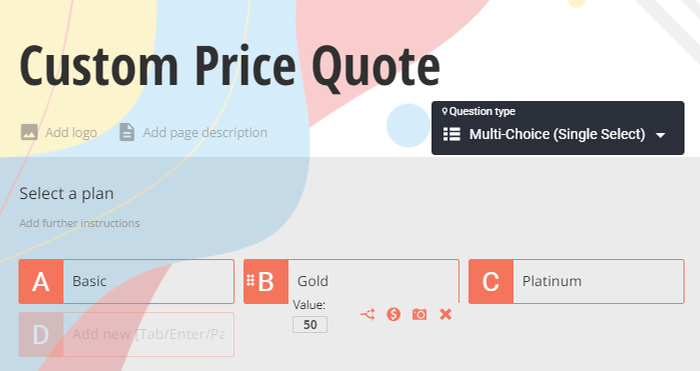
Pro Tip: If a question is mandatory, you can enabled the “Required” option in the question settings to ensure respondents provide an answer.
Building a formula
To calculator your final results you’ll need to build a formula. To do this, go to the Results exit page and click “Add New Result”.
From here you can customize the content that appears along side the calculator result. We’ll come back to this later, as for now we want to build a formula.
Click the + icon next to “Select a formula” and you’ll be taken to the formula builder.
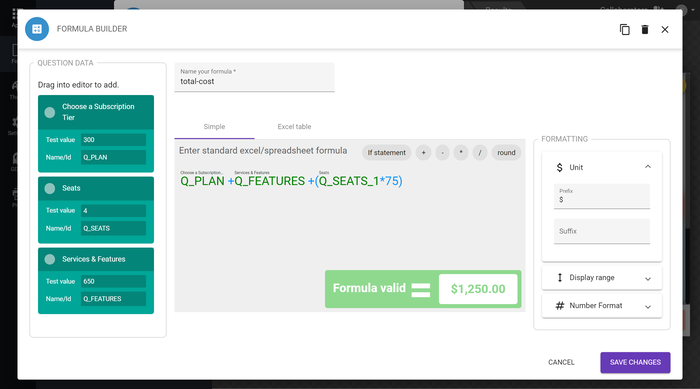
Then simply drag and drop calculator questions from the left into your formula.
We’ll highlight any questions you add to your formula in blue, so you always know what you’re using or what may be missing.
Select from a range of operators and functions in the builder, or use almost all functions available in tools like Excel and Sheets.
For our formula, we’ll be adding the cost of the plan to the cost of the seats.
Step 4. Display results
Finally, you’ll need to choose how you want the quote to be displayed to potential customers. By default, results (price quotes) will be displayed on an exit page once a response has been submitted.
Real-time calculator results
Firstly, you could display the price quote in real-time alongside your calculator.

Results exit page
Alternatively, you can wait to show results until the potential customer reaches the Exit Page (after they’ve filled out all calculator fields).
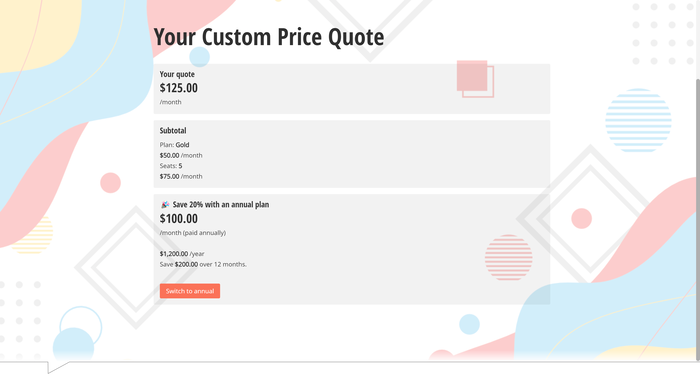
This works especially well if you want to email gate the price quote.
What do we mean by that? Simply put, it’s where want collect contact information (such as names and email addresses) before displaying results.
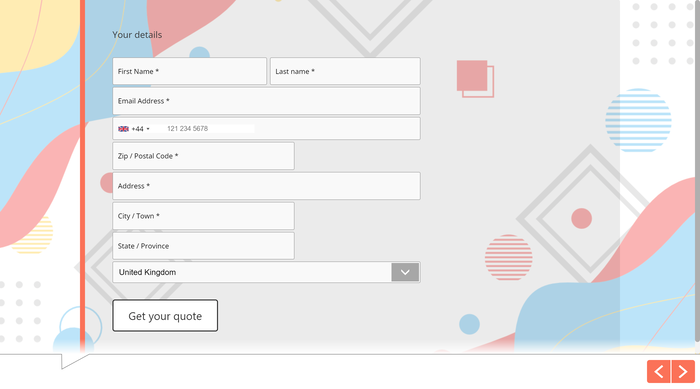
So in this example, you’d have a page for calculator fields, then a page for contact information, then finally the results page.
You’ll have full control of what information is collected in contact forms with Shout. Whether you want to collect just names and email addresses or the whole shebang.
Features to make your price quote calculator shine
Here are some features we think will really benefit you when creating a price quote calculator with Shout.
| Features | What it does |
|---|---|
| Call-to-actions | Add a CTA to results blocks to prompt user actions. |
| Redirects | Redirect potential customers on submission of their response to a website or landing page. |
| Answer piping | Pipe answer text and contact information into calculators and results to personalize experiences. |
| Conditional messages | Trigger custom messages for potential customers based on their final scores. |
| Integrated CRM | Store contact information you collect with calculators in Shout’s integrated CRM. |
| Collect & record consent | Collect explicit consent from leads to add them to your email lists and record it to their customer profiles in the CRM. |
How to embed custom price quote calculators on your website
Once you’ve finished creating your interactive calculator, it’ll be time to decide how you want to share it.
You’ll have many distribution options with Shout, including email invitations, QR codes, popups and slideouts.
But, the most popular option for sharing calculators is embedding them on your website.

Simply head to the Send stage of your calculator, then click “Get the code” beneath the Embed option.
From here you can choose between a fixed height or set a custom height for your calculator.
Then it’s just a case of copying the code and pasting it onto your website.
If you’re using a CMS like WordPress or Wix, you can paste this code into a HTML block.



